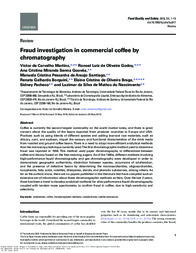Fraud investigation in commercial coffee by chromatography.
Fraud investigation in commercial coffee by chromatography.
Autoria: MARTINS, V. de C.; GODOY, R. L. de O.; GOVÊA, A. C. M. S.; SANTIAGO, M. C. P. de A.; BORGUINI, R. G.; BRAGA, E. C. de O.; PACHECO, S.; NASCIMENTO, L. da S. de M. do
Resumo: Coffee is currently the second largest commodity on the world market today, and there is great concern about the quality of the beans exported from producer countries to Europe and USA. Practices such as using blends of different species and adding low-cost raw materials, such as chicory, corn, and soybean, impair the sensory and functional characteristics of the drink made from roasted and ground coffee beans. There is a need to adopt more efficient analytical methods than the microscopy technique currently used. The first chromatographic method used to determine fraud was reported in 1958. This method used paper chromatography to differentiate between coffee and chicory based on the free reducing sugars. As of the 1980s, different methods involving high-performance liquid chromatography and gas chromatography were developed in order to demonstrate geographic authenticity, distinction between species, occurrence of adulteration, and the presence of defective beans by determining the monosaccharides, oligosaccharides, tocopherols, fatty acids, volatiles, diterpenes, sterols, and phenolic substances, among others. As far as the authors know, there are no papers published in the literature that have compiled such an extensive set of information about these chromatographic methods as here. Over the last 2 years, there has been a trend to develop analytical methods for ultra-performance liquid chromatography coupled with tandem mass spectrometry to confirm fraud in coffee, due to high sensitivity and selectivity.
Ano de publicação: 2018
Tipo de publicação: Artigo de periódico
Unidade: Embrapa Agroindústria de Alimentos
Observações
1 - Por padrão são exibidas publicações dos últimos 20 anos. Para encontrar publicações mais antigas, configure o filtro ano de publicação, colocando o ano a partir do qual você deseja encontrar publicações. O filtro está na coluna da esquerda na busca acima.
2 - Para ler algumas publicações da Embrapa (apenas as que estão em formato ePub), é necessário ter, no celular ou computador, um desses softwares gratuitos. Sistemas Android: Google Play Livros; IOS: iBooks; Windows e Linux: software Calibre.
Acesse outras publicações
Acesse a Base de Dados da Pesquisa Agropecuária (BDPA) para consultar o acervo completo das bibliotecas da Embrapa.

